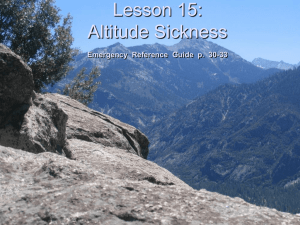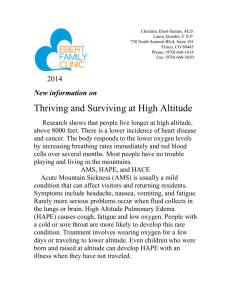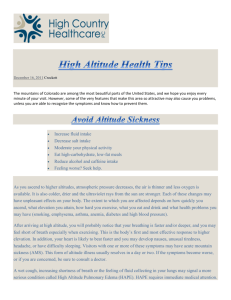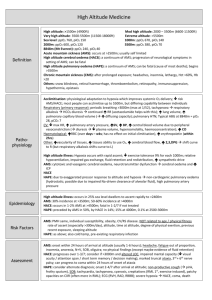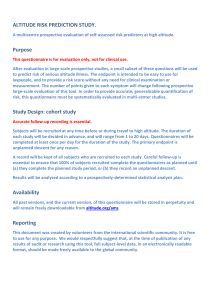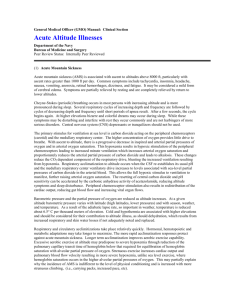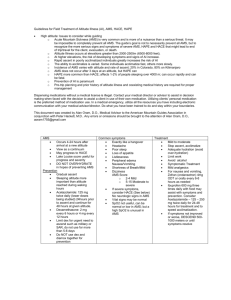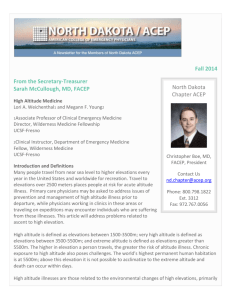altitudeillnessfortrekkers
advertisement
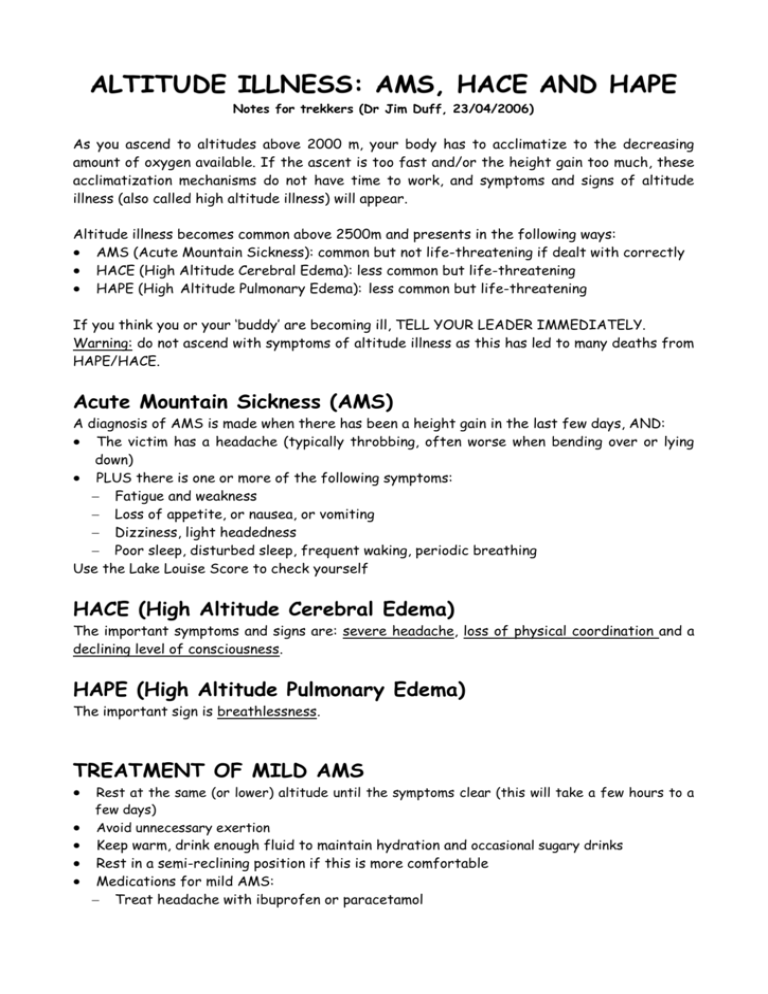
ALTITUDE ILLNESS: AMS, HACE AND HAPE Notes for trekkers (Dr Jim Duff, 23/04/2006) As you ascend to altitudes above 2000 m, your body has to acclimatize to the decreasing amount of oxygen available. If the ascent is too fast and/or the height gain too much, these acclimatization mechanisms do not have time to work, and symptoms and signs of altitude illness (also called high altitude illness) will appear. Altitude illness becomes common above 2500m and presents in the following ways: AMS (Acute Mountain Sickness): common but not life-threatening if dealt with correctly HACE (High Altitude Cerebral Edema): less common but life-threatening HAPE (High Altitude Pulmonary Edema): less common but life-threatening If you think you or your ‘buddy’ are becoming ill, TELL YOUR LEADER IMMEDIATELY. Warning: do not ascend with symptoms of altitude illness as this has led to many deaths from HAPE/HACE. Acute Mountain Sickness (AMS) A diagnosis of AMS is made when there has been a height gain in the last few days, AND: The victim has a headache (typically throbbing, often worse when bending over or lying down) PLUS there is one or more of the following symptoms: Fatigue and weakness Loss of appetite, or nausea, or vomiting Dizziness, light headedness Poor sleep, disturbed sleep, frequent waking, periodic breathing Use the Lake Louise Score to check yourself HACE (High Altitude Cerebral Edema) The important symptoms and signs are: severe headache, loss of physical coordination and a declining level of consciousness. HAPE (High Altitude Pulmonary Edema) The important sign is breathlessness. TREATMENT OF MILD AMS Rest at the same (or lower) altitude until the symptoms clear (this will take a few hours to a few days) Avoid unnecessary exertion Keep warm, drink enough fluid to maintain hydration and occasional sugary drinks Rest in a semi-reclining position if this is more comfortable Medications for mild AMS: Treat headache with ibuprofen or paracetamol Consider treating persistent nausea or vomiting with prochlorperazine (Stemetil™) or other anti-vomiting medication Consider starting acetozolamide (Diamox™) 125 to 250 mg 12-hourly for the rest of the time at altitude Hypothermia, dehydration and low blood sugar (due to not eating) share many symptoms and signs with AMS and may be present at the same time. So always re-warm, re-hydrate, re-sugar If the illness is more severe, DESCEND. Other specific treatments will be given by your leader/doctor. Preventing altitude illness Above 2000m, altitude illness (AMS, HACE and HAPE) is a possibility, and above 2500m it becomes common. As a rough guide, above 2500m the maximum daily height gain between sleeping altitudes should not exceed 300m (slow acclimatizers) to 500m (fast acclimatizers), with a rest day every third day (or after every 1000m of ascent). Over 5000m, the daily height gain for the slow and fast acclimatizers is halved to 150m and 250 meters per day, respectively If you must fly or drive rapidly to 2500m or higher, spend a minimum of two nights at your arrival altitude (or lower if possible) or until symptoms disappear, before ascending further. If ascending rapidly to 3000m or higher, consider using acetozolamide (Diamox™) Avoid overexertion and breathlessness while acclimatizing, especially if experiencing symptoms of AMS Drink enough liquid to keep your urine pale and plentiful Avoid alcohol, excess caffeine, salt and protein (your diet should be 70% carbohydrate above 3500m) Warning: do not ascend with symptoms of AMS, consult your leader/doctor Acetazolamide (Diamox™) Acetozolamide does NOT mask the onset of AMS, HACE or HAPE. A dose takes 12 hours to become fully effective. However, taking acetozolamide does not guarantee that altitude illness will not develop. There are 3 situations where acetozolamide is useful: 1. Prevention of AMS. 2. Treatment of altitude illness. 3. Poor sleep, disturbed sleep or periodic breathing at altitude Side effects include: Paraesthesiae (tingling) in lips, fingers, toes or other body parts and a metallic taste when drinking carbonated drinks are the most obvious. Both side effects are milder with lower doses and disappear on stopping the medication Acetozolamide can cause photosensitivity (sunburn more easily) so use hats, gloves, sunscreen Extra urine output. The effect of acetozolamide to increase urine output is mild (people pee more as part of the normal acclimatization process as they ascend)
